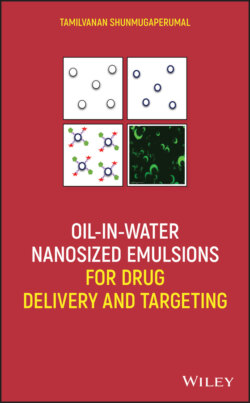Читать книгу Oil-in-Water Nanosized Emulsions for Drug Delivery and Targeting - Tamilvanan Shunmugaperumal - Страница 50
2.5.1.7. Optimization of Responses for Formulation of CsA‐Loaded Nanosized Emulsion
ОглавлениеBy using graphical optimization, an overlay plot (Fig. 2.7g) showing the obtained design space (highlighted) was produced by the Design‐Expert® software. From the overlay plot, the design space representing desired amounts of CPPs and the selected CQAs (R1:MPS, R2:PDI, and R3:ZP) values of topical ophthalmic emulsions was found out. Within the design space, the optimized formula was selected that consists of minimum MPS and PDI values but maximum ZP value. The CPPs amounts found in the optimized formula are 1.39 ml castor oil, 6 mg chitosan, and 75 mg poloxamer. Similarly, the CQAs values established for the optimized formula within the design space are 260.173 nm, 0.275 and 25.85 mV, respectively, for MPS, PDI, and ZP.
To substantiate further the established optimized formula for topical ophthalmic emulsion within the design space, the predictability of chosen face‐centered CCD model is at first corroborated by evaluating the randomly selected six different formulae along with the optimized formula for the actual CQAs values and comparing them with the predicted CQAs values. The diagnostic plot of actual versus predicted CQAs (R1:MPS, R2:PDI, and R3:ZP) values are shown in Fig. 2.7a–f. Interestingly, the actual versus predicted plots for all of the CQAs were shown the r2 value of greater than 0.9 indicating the establishment of the closeness between the values and hence conformed/justified the predictability of chosen model within the design space (Fig. 2.7b, d, and f). The value of randomness of scatter and deviations was found to be within ±4% in residual versus predicted value plot (Fig. 2.7a, c, and e). Furthermore, the chosen model also showed an overall mean percent error value of 0.30 ± 0.13%. In addition, an adequate precision should measure the signal‐to‐noise ratio, and its value of greater than 4 is desirable. As per the selected face‐centered CCD model, the signal‐to‐noise ratio values shown by Design‐Expert® software for MPS, PDI, and ZP were 8.701, 6.415, and 4.6524, respectively. This directly indicates that the adequate precision is produced and therefore this model can be used to navigate the design space to find out the optimized formula for topical ophthalmic emulsion.
